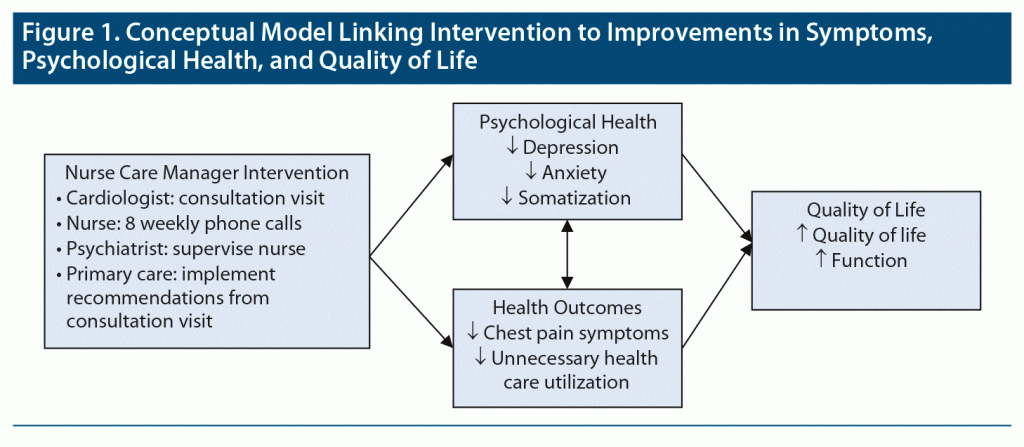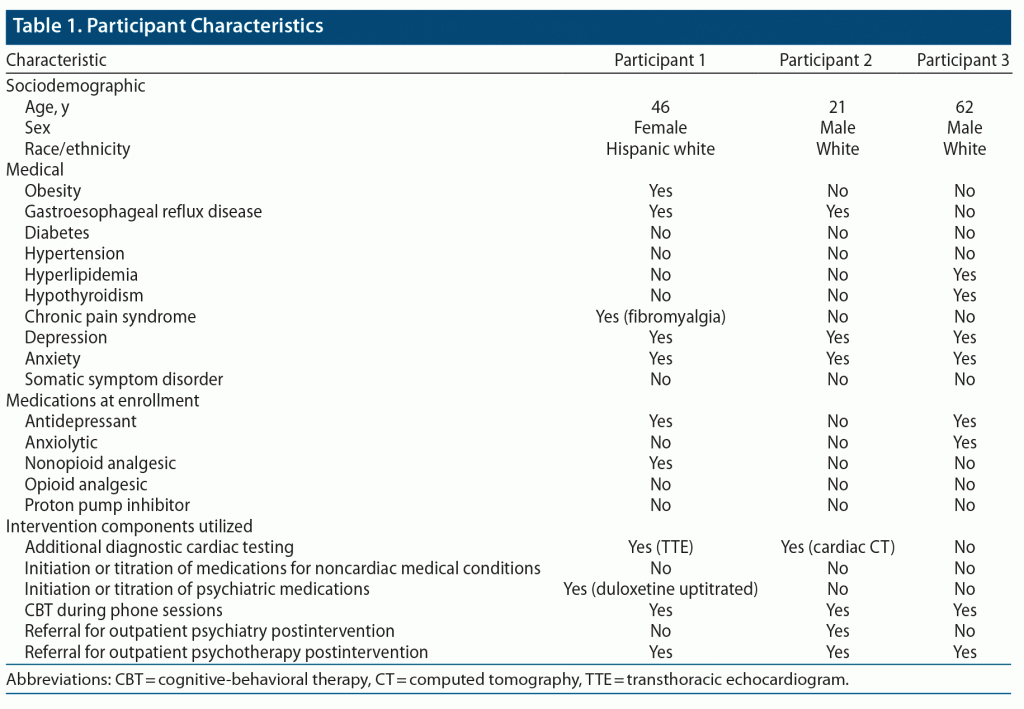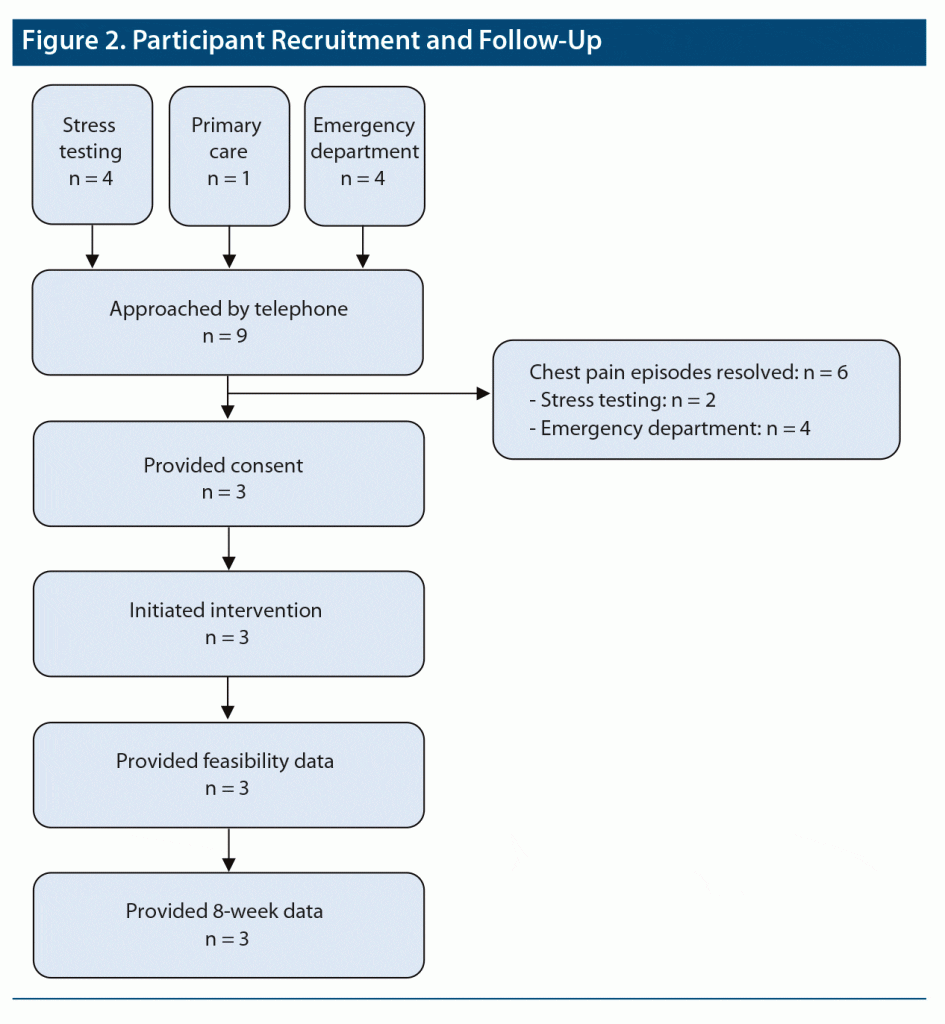ABSTRACT
Objective: Noncardiac chest pain is common and can cause distress, impair quality of life, and lead to recurrent evaluation. It is often multifactorial in etiology and influenced by psychological factors. The objective of this study was to describe the development, implementation, and preliminary feasibility of an 8-week multicomponent care management intervention.
Methods: Participants with noncardiac chest pain were recruited from primary care clinics, ambulatory cardiac stress testing, and the emergency department (ED) at an urban academic hospital from March 2019 to November 2019. The care management team consisted of a nurse, cardiologist, and psychiatrist. Following a 1-time consultation visit with the cardiologist and nurse, evaluation and treatment recommendations were conveyed to the participant’s primary care physician. The nurse completed 8 weekly phone calls with the participant to provide support, introduce therapeutic principles, and assist with care coordination under the supervision of a psychiatrist. Intervention feasibility was assessed on 7 domains. To examine preliminary efficacy, the number of ED visits was recorded, and participants completed pre-post measures of psychological health and health-related quality of life and Likert scales of chest pain symptom severity, frequency, and impact.
Results: The intervention was developed and implemented in 3 patients who completed 100% of the consultation visits and a mean of 95.8% of study phone calls. There were no adverse events or ED visits. Mean scores for chest pain severity, chest pain frequency, chest pain impact, depression, anxiety, and somatization all improved. No other trends were observed.
Conclusions: The findings suggest that a care management intervention may be feasible with potential to improve chest pain symptoms and psychological outcomes. A larger, randomized trial is needed to explore the efficacy of this intervention.
Trial Registration: ClinicalTrials.gov identifier: NCT04904198.
Prim Care Companion CNS Disord 2022;24(2):21m03045
To cite: Madva EN, Celano CM, Kim S, et al. A care management intervention for noncardiac chest pain: treatment development and feasibility assessment. Prim Care Companion CNS Disord. 2022;24(2):21m03045.
To share: https://doi.org/10.4088/PCC.21m03045
© Copyright 2022 Physicians Postgraduate Press, Inc.
aHarvard Medical School, Boston, Massachusetts
bDepartment of Psychiatry, Massachusetts General Hospital, Boston, Massachusetts
cHarvard T.H. Chan School of Public Health, Boston, Massachusetts
dDivision of Cardiology, Department of Medicine, Massachusetts General Hospital, Boston, Massachusetts
eInova Heart and Vascular Institute, Falls Church, Virginia
fDepartment of Psychology, Drexel University, Philadelphia, Pennsylvania
*Corresponding author: Elizabeth N. Madva, MD, Massachusetts General Hospital, Warren 6, Boston, MA 02114 ([email protected]).
Chest pain is the second most common reason that patients present to the emergency department (ED) in the United States,1 accounting for over 7 million ED visits1 and as many as 27 million office visits2,3 each year. Although this presenting complaint typically prompts urgent or emergent evaluation to rule out life-threatening cardiac etiologies, more than half of all patients presenting to the ED4 and more than two-thirds presenting to primary care5 do not have underlying cardiac disease. This noncardiac chest pain (NCCP), a recurring chest pain of noncardiac origin, appears to have a lifetime prevalence of approximately 33%6 and represents a significant burden to patients and providers.7
NCCP is a heterogenous condition associated with many causes. Common contributors include gastroesophageal reflux disease (GERD), musculoskeletal disease, respiratory illness, and psychiatric illness (eg, panic disorder).8 Compared to patients with cardiac chest pain, patients with NCCP tend to be younger,9 to be women,9 and to have atypical symptoms.8 Although the underlying cause is often unclear, the symptoms of chest pain persist: 58% of patients report pain 16 months after evaluation,10 and 35% report pain at 3 years.9 A majority of patients remain unconvinced by their negative cardiac workup8,9 and continue to seek further cardiac assessment despite diagnostic reassurance.11
This behavior leads to increased health care utilization and costs.12,13 Patients with NCCP are dissatisfied with their care9 and have more frequent medical visits than patients with ischemic heart disease.14 In the United States each year, NCCP leads to $8 to $13 billion in direct costs7,15,16 as well as substantial indirect costs (eg, absenteeism).7,17 The total annual cost of NCCP may exceed the cost for acute coronary syndrome.12
Health-related quality of life (HRQoL) in patients with NCCP is severely impaired.17 There is evidence that NCCP patients suffer worse quality of life compared to healthy controls,18 other chronic pain patient groups,19 and patients with cardiac chest pain.7 Several factors contribute to this low HRQoL, including lack of a clear diagnosis/ongoing worry about symptom etiology, pain catastrophizing, social withdrawal, pain-related activity limitation or avoidance, poor work performance, and presence of comorbid psychiatric conditions such as anxiety and depression.7,9,11,20
Several interventions for NCCP have been evaluated.21 Cognitive-behavioral therapy (CBT), hypnosis, breathing training, and pharmacotherapeutic approaches have been studied.22 CBT appears to be the most effective psychological treatment for NCCP, though hypnosis may be an effective alternative.23 For NCCP patients with hyperventilation, diaphragmatic breathing training appears to be beneficial.24 In terms of medications for NCCP, a trial of an empiric proton pump inhibitor is often recommended to target undiagnosed GERD symptoms,25 but insufficient evidence exists to support the use of antidepressants (when NCCP alone is the indication).26 Given the heterogeneous and multifactorial nature of NCCP, determining which intervention to pursue for an individual patient can be challenging.
Care management approaches, which combine the expertise and availability of different providers to provide comprehensive assessment and customized treatment, appear particularly promising. Chambers and colleagues27 described the pilot development of a multidisciplinary clinic in the United Kingdom that provided a comprehensive NCCP assessment followed by a biopsychosocial explanation of chest pain symptoms. Following the assessment, patients were recommended medical therapy (eg, medication for GERD), 6 sessions of low-intensity self-help CBT for mild psychological factors, or 8 sessions of high-intensity CBT for more complex cases. They found that this “stepped care” approach led to significant improvements in chest pain frequency and interference/impact, depression and anxiety symptoms, work and social functioning, and health care utilization at 6 months.27
Accordingly, this pilot project aimed to describe the degree of psychological distress in our NCCP population and to determine whether a nurse care manager intervention conducted primarily by telephone, with physician (cardiology and psychiatry) support, could be feasible with potential to improve symptoms and HRQoL.
METHODS
Overview
We developed an 8-week multidisciplinary care management intervention for NCCP and explored preliminary feasibility, acceptability, and impact in a single-arm proof-of-concept trial in a small number of participants (n = 3). Participants with NCCP were recruited from primary care clinics, ambulatory cardiac stress testing, and the ED at an urban academic hospital from March 2019 to November 2019. The study was approved by the Mass General Brigham Healthcare System Institutional Review Board and registered on ClinicalTrials.gov (NCT04904198). All participants provided written informed consent.
Participants
Study criteria. The following inclusion criteria were required for eligibility:
(1) Noncardiac chest pain: defined as chest pain recurring at least once per week for 2 weeks with at least 2 of the following objective tests: electrocardiogram without ischemic changes, negative cardiac enzymes, or nonischemic cardiac stress test.
(2) Primary care physician (PCP) affiliation: to ensure the ability to communicate diagnostic impressions and treatment recommendations, each participant had a PCP at an affiliated hospital or clinic.
Exclusion criteria included (1) history or subsequent diagnosis of cardiac disease, (2) objectively diagnosed alternative medical etiology of chest pain (eg, GERD), (3) resolution of chest pain prior to enrollment, (4) cognitive impairment assessed using a 6-item screen,28 (5) inability to communicate in English, or (6) lack of telephone access (precluding weekly phone calls).
Recruitment and enrollment. Participants were recruited from the ED, primary care clinics, and a cardiac stress testing center at an urban academic hospital, identified by clinicians or research staff (with clinician support) in each respective setting. Potential participants were provided with a fact sheet and if interested in being contacted were called 2 weeks after recruitment to confirm presence of ongoing chest pain symptoms meeting study inclusion criteria. To ensure clinical appropriateness and safety for study participation, test results were reviewed by a cardiologist. Permission for participation was obtained from each patient’s PCP. After eligibility was confirmed, participants were scheduled for a single in-person consultation visit with the study cardiologist and nurse care manager, at which time participants provided written informed consent prior to participating in any study procedures.
Intervention
The goal of this intervention was to establish a diagnosis of NCCP, identify factors contributing to NCCP symptomatology, and develop an individualized treatment plan tailored to each participant’s needs. Building off prior work,27,29 we developed an intervention with the following components. Figure 1 provides a conceptual model linking the intervention to desired outcomes.
Consultation visit. At the study consultation visit, participants met with a nurse care manager and cardiologist. Current chest pain symptoms, psychiatric symptoms, sources of potential psychosocial stress, and medical and psychiatric history were gathered in a structured interview by the nurse care manager. The cardiologist then completed a standard-of-care evaluation and examination of the patient’s chest pain symptoms. Next, the study cardiologist, nurse care manager, and study psychiatrist together reviewed all diagnostic information gathered, including baseline questionnaires evaluating for the presence of psychiatric diagnoses and patient-reported sources of psychosocial stress, to inform a holistic biopsychosocial formulation with treatment recommendations, which was subsequently shared with the patient. A plan to complete 8 phone calls over the following 8 weeks with the nurse care manager was established.
Communication with primary care. After the study visit, diagnostic impressions and treatment recommendations were communicated to the patient’s PCP for implementation. Treatment recommendations included antidepressant initiation or titration and referrals to individual therapy (eg, CBT, grief counseling), based on participants’ specific symptoms and preferences. The PCP was also updated at the conclusion of the 8-week intervention and provided with additional recommendations when indicated.
Weekly phone calls. The nurse care manager and participant completed 8 weekly phone calls after the consultation visit. During the calls, the nurse care manager completed a series of structured questions, inquiring about symptoms (eg, how many episodes of chest pain since last contact, Likert scales of chest pain symptoms, status of comorbid medical and mental health conditions), psychosocial stressors (eg, work, relationships, finances), and any safety concerns or adverse events. The nurse care manager also reviewed treatment recommendations that had been recommended to the PCP, provided education about the possible relationship between chest pain symptoms and mental health, provided support, and assessed cognitions, emotions, and behaviors related to the chest pain utilizing a CBT framework. CBT exercises such as completing thought and emotion records and progressive muscle relaxation, as well as diaphragmatic breathing, were introduced and practiced when indicated. Throughout the 8-week intervention, the nurse care manager also met weekly with the study psychiatrist to review the content of each phone call, generate a plan for the next phone session, and receive supervision on the implementation of CBT techniques.
Outcomes
Data were collected at baseline and throughout the 8-week study period. Baseline participant characteristics (sociodemographics, medical history, medications) were collected at the consultation visit, with information supplemented by the medical record. Study outcome measures were completed at the consultation visit and following the final phone call at 8 weeks.
Primary Outcome: Feasibility
Consistent with prior research,30,31 the feasibility of the intervention was evaluated based on several areas: implementation, recruitment, adherence, acceptability, attrition, safety, and data collection.
Implementation. We assessed whether it would be possible to identify, train, coordinate, retain, and supervise clinicians (eg, cardiologist, nurse); reserve clinic space; schedule multidisciplinary consultation visits; and obtain approval and support from PCPs.
Recruitment. Data were collected on the proportion of individuals interested in the study who met eligibility criteria for participation.
Adherence. A priori, we defined feasible adherence as 100% completion of the consultation visit and a mean completion of at least half of the 8 phone calls over the 8-week study period, consistent with prior behavioral health telephone interventions.32,33
Acceptability. During weekly phone calls, participants were asked about the ease and utility of the phone calls, as well as their experience of the intervention and if/how it was impacting their chest pain experience and HRQoL. This information was collected qualitatively.
Attrition. We defined an attrition rate ≤ 15% as indicating feasibility, based on prior treatment development and feasibility research.31
Safety. Any adverse psychological or physical symptoms were documented at the consultation visit, and phone sessions with appropriate follow-up were provided as needed to ensure safety.
Data collection. We assessed whether participants would be able to complete all baseline and follow-up study measures.
Secondary Outcomes: Pre-Post Change
Key secondary outcomes included chest pain symptom severity, frequency, and impact (10-point Likert scales), number of ED visits before and during the intervention, and validated measures of depression (9-item Patient Health Questionnaire [PHQ-9]34), anxiety (7-item Generalized Anxiety Disorder Screener [GAD-7]35), somatic symptom disorder (15-item Patient Health Questionnaire [PHQ-15]36), and physical and mental HRQoL (12-item Short-Form Health Survey [SF-12]37).
Statistical Analysis
Descriptive statistics, including means and standard deviations, were utilized to characterize the outcomes of this initial exploration of proof of concept. Qualitative information regarding the intervention’s acceptability was also collected.
RESULTS
Patient Characteristics
Three eligible patients were enrolled. Baseline sociodemographic, medical, and psychological characteristics are provided in Table 1. Baseline data were notable for a history of depression and anxiety in all 3 participants. A summary of intervention components utilized for each patient is also provided in Table 1. Two participants were recommended to have additional cardiac diagnostic testing following the study cardiologist’s examination (to complete the diagnostic workup), which was unremarkable in both cases. Psychiatric medication initiation or titration was recommended for all 3 participants based on the comprehensive consultation visit assessment but only implemented in 1 patient. CBT techniques were utilized during phone sessions for all 3 participants.
Primary Outcome: Feasibility
Implementation. We were able to implement a multidisciplinary intervention with PCP support.
Recruitment. Of 9 patients who were referred and approached by telephone, only 3 (33.3%) met the study inclusion criteria and were subsequently enrolled. The universal reason for lack of study eligibility was resolution of chest pain episodes following referral to the study and prior to eligibility assessment. Of the participants who successfully enrolled, 2 were referred following stress testing, and 1 was referred from primary care (Figure 2).
Adherence. All 3 participants (100%) completed the consultation visit. Two participants completed 8/8 calls (100%), and 1 participant completed 7/8 (87.5%) calls, for a mean completion of 95.8% of phone calls. The reason for the missed phone call was a death in the family.
Acceptability. The intervention was well received by participants. All 3 patients reported finding the intervention to be highly acceptable in terms of ease, utility, and impact on their experience of chest pain symptoms. At the conclusion of the intervention, all 3 participants noted a greater awareness of and insight into the factors contributing to their experience of chest pain, as reflected in the following sample quotes:
“I’m having less chest pain, and I realize it’s triggered by stress.” (Participant 1)
“I realize what happens more and note what’s going on because I know I have to say it on the calls.” (Participant 2)
“I’ve figured out the chest pain happens mostly at work.” (Participant 3)
Attrition. No participants dropped out of the study after enrollment.
Safety. No adverse events occurred during the study.
Data collection. All 3 participants (100%) completed all study outcome measures at baseline and follow-up. No data were excluded.
Secondary Outcomes: Pre-Post Change
Results of study outcome measures are summarized in Table 2. Nearly all study outcome measures trended in the expected direction. Raw scores for chest pain severity and somatization improved across all participants. Means for chest pain frequency, chest pain impact, depression, anxiety, and number of ED visits also improved. Notably, the mean PHQ-9 score at baseline was 10.7, representing moderate depression, and improved to 6.3, representing mild depression. The mean GAD-7 score at baseline was 9.7, representing moderate anxiety, and improved to 5.3, representing mild anxiety. The mean PHQ-15 score at baseline was 13.3, representing moderate somatization, and improved to 8.0, representing mild somatization. Effects on quality of life were mixed, with the SF-12 demonstrating a mean improvement in physical health–related quality of life but not mental health–related quality of life.
DISCUSSION
Preliminary observations from this exploration of proof-of-concept suggest that a care management intervention for patients with NCCP may be feasible with potential to improve symptoms and psychological outcomes. All participants completed the consultation visit, 100% of the baseline and follow-up outcome measures, and > 95% of calls, which was well above our a priori threshold for feasibility. Additionally, we were able to develop procedures, identify and train clinicians, and obtain PCP support for this multicomponent intervention. The intervention was well accepted by participants, who described the intervention as helpful. These findings suggest that a care management intervention has the potential to be successfully implemented and acceptable to participants in future larger trials.
Several observations from this exploration of proof-of-concept are worth highlighting. First, symptoms of depression, anxiety, somatization, and chest pain all trended toward improvement. In particular, the raw scores for the PHQ-15, a measure of somatization and somatic symptom severity, improved dramatically for each participant, such that each participant improved to at least 1 level of severity lower on that scale (eg, from severe to moderate). Several factors likely contributed to these trends. As noted previously, CBT techniques were implemented during phone calls with each participant. Psychiatric medication initiation or titration was also recommended for all 3 participants but only implemented for one, suggesting that perhaps even greater improvement might have been observed had treatment recommendations been followed. One participant also experienced a personal loss during the study period, which may have impacted scores. Assessment of symptoms and delivery of the diagnostic formulation by a cardiologist likely provided greater credibility to treatment recommendations. Consistent with one of the classic recommendations for treating somatic symptom disorder, the intervention involved the scheduling of regular visits (in this case phone calls) not contingent on active symptoms.38 Collectively, these factors may have contributed to the mean reduction in the number of ED visits observed during the study period.
Second, each of the participants had a prior history of depression and anxiety as well as elevated scores on baseline measures of depression and anxiety, consistent with reported high rates of psychiatric illness in the NCCP population.22 One study39 found that 75.7% of NCCP patients have comorbid psychiatric illness, with a rate of 21.4% for depressive disorders and 58.5% for anxiety disorders. This finding highlights the importance of screening for psychiatric illness in NCCP patients. Furthermore, our preliminary findings could be interpreted to suggest that this care management approach may be particularly useful for NCCP patients with comorbid depression or anxiety, and perhaps this subset of the NCCP population should be targeted in future trials.
Finally, there are potential implications for our understanding of the NCCP syndrome. In contrast to the literature, which suggests that chest pain symptoms typically persist,9,10 the majority of patients referred to this study (6/9, or 66.7%) experienced a resolution of their chest pain symptoms between the time of referral and eligibility assessment. This finding suggests that the nature of NCCP may be more intermittent (eg, recurring after longer intervals) or more transient than previously described.
Study limitations include the small sample size, lack of a control group, and recruitment from a single, urban academic hospital. Despite these limitations, this project demonstrates an approach to development of an intervention that, in a preliminary assessment, appears to be feasible and well accepted with potential to improve chest pain symptoms, psychological outcomes, and health care utilization. A randomized, controlled pilot trial to assess the efficacy of this intervention should be pursued. Future trials would also be useful in further characterizing and refining the target population by examining the impact of baseline functional impairment, level of health care utilization, and comorbid psychiatric illness on intervention response. If effective, such an intervention has the potential to improve chest pain symptoms, psychological health, and downstream health outcomes in this high comorbidity population.
Submitted: June 9, 2021; accepted September 28, 2021.
Published online: April 19, 2022.
Relevant financial relationships: None.
Funding/support: This work was supported by a philanthropic donation without attribution and a National Institutes of Health Research Education Grant (R25MH094612) supporting Dr Madva.
Role of the sponsor: The supporters had no role in the design, analysis, interpretation, or publication of this study.
Acknowledgments: The authors thank Donna Tito, RN, and Meaghan Rudolph, PCNS, at Massachusetts General Hospital (MGH) for nurse care manager assistance and the MGH emergency department (ED) research team led by Blair Alden Parry, BA, CCRC, and Michael Filbin, MD, for identifying potential participants and supporting ED study operations. The acknowledged individuals have no conflicts of interest related to the subject of this article.
Clinical Points
- Clinicians should assess for the presence of comorbid psychiatric disease in patients presenting with noncardiac chest pain.
- Care management programs for noncardiac chest pain may have the potential to improve chest pain symptoms, psychological outcomes, and health care utilization.
References (39)

- Rui PKK. National Hospital Ambulatory Medical Care Survey: 2017 Emergency Department Summary Tables. National Center for Health Statistics. CDC website. Accessed March 22, 2022. https://www.cdc.gov/nchs/data/nhamcs/web_tables/2017_ed_web_tables-508.pdf
- Rui POT. National Ambulatory Medical Care Survey: 2016 National Summary Tables. CDC website. Accessed March 22, 2022. https://www.cdc.gov/nchs/ahcd/ahcd_products.htm
- Frese T, Mahlmeister J, Heitzer M, et al. Chest pain in general practice: frequency, management, and results of encounter. J Family Med Prim Care. 2016;5(1):61–66. PubMed CrossRef
- Bhuiya FA, Pitts SR, McCaig LF. Emergency department visits for chest pain and abdominal pain: United States, 1999–2008. NCHS Data Brief. 2010;(43):1–8. PubMed
- Haasenritter J, Biroga T, Keunecke C, et al. Causes of chest pain in primary care: a systematic review and meta-analysis. Croat Med J. 2015;56(5):422–430. PubMed CrossRef
- Eslick GD, Jones MP, Talley NJ. Non-cardiac chest pain: prevalence, risk factors, impact and consulting: a population-based study. Aliment Pharmacol Ther. 2003;17(9):1115–1124. PubMed CrossRef
- Eslick GD, Talley NJ. Non-cardiac chest pain: predictors of health care seeking, the types of health care professional consulted, work absenteeism and interruption of daily activities. Aliment Pharmacol Ther. 2004;20(8):909–915. PubMed CrossRef
- Dumville JC, MacPherson H, Griffith K, et al. Non-cardiac chest pain: a retrospective cohort study of patients who attended a rapid access chest pain clinic. Fam Pract. 2007;24(2):152–157. PubMed CrossRef
- Mayou R, Bryant B, Forfar C, et al. Non-cardiac chest pain and benign palpitations in the cardiac clinic. Br Heart J. 1994;72(6):548–553. PubMed CrossRef
- Ockene IS, Shay MJ, Alpert JS, et al. Unexplained chest pain in patients with normal coronary arteriograms: a follow-up study of functional status. N Engl J Med. 1980;303(22):1249–1252. PubMed CrossRef
- Shelby RA, Somers TJ, Keefe FJ, et al. Pain catastrophizing in patients with noncardiac chest pain: relationships with pain, anxiety, and disability. Psychosom Med. 2009;71(8):861–868. PubMed CrossRef
- Mourad G, Alwin J, Strömberg A, et al. Societal costs of non-cardiac chest pain compared with ischemic heart disease: a longitudinal study. BMC Health Serv Res. 2013;13(1):403. PubMed CrossRef
- Hadlandsmyth K, Rosenbaum DL, Craft JM, et al. Health care utilisation in patients with non-cardiac chest pain: a longitudinal analysis of chest pain, anxiety and interoceptive fear. Psychol Health. 2013;28(8):849–861. PubMed CrossRef
- Tew R, Guthrie EA, Creed FH, et al. A long-term follow-up study of patients with ischaemic heart disease versus patients with nonspecific chest pain. J Psychosom Res. 1995;39(8):977–985. PubMed CrossRef
- Kahn SE. The challenge of evaluating the patient with chest pain. Arch Pathol Lab Med. 2000;124(10):1418–1419. PubMed CrossRef
- Hutter AM Jr, Amsterdam EA, Jaffe AS. 31st Bethesda Conference. Emergency Cardiac Care. Task force 2: acute coronary syndromes: section 2B–chest discomfort evaluation in the hospital. J Am Coll Cardiol. 2000;35(4):853–862. PubMed
- Eslick GD, Coulshed DS, Talley NJ. The burden of illness of non-cardiac chest pain. Aliment Pharmacol Ther. 2002;16(7):1217–1223. PubMed CrossRef
- Ortiz-Garrido O, Ortiz-Olvera NX, González-Martínez M, et al. Clinical assessment and health-related quality of life in patients with non-cardiac chest pain. Rev Gastroenterol Mex. 2015;80(2):121–129. PubMed CrossRef
- Mourad G, Alwin J, Jaarsma T, et al. The associations between psychological distress and health-related quality of life in patients with non-cardiac chest pain. Health Qual Life Outcomes. 2020;18(1):68. PubMed CrossRef
- Castonguay J, Turcotte S, Fleet RP, et al. Physical activity and disability in patients with noncardiac chest pain: a longitudinal cohort study. Biopsychosoc Med. 2020;14(1):12. PubMed CrossRef
- Burgstaller JM, Jenni BF, Steurer J, et al. Treatment efficacy for non-cardiovascular chest pain: a systematic review and meta-analysis. PLoS One. 2014;9(8):e104722. PubMed CrossRef
- Campbell KA, Madva EN, Villegas AC, et al. Non-cardiac chest pain: a review for the consultation-liaison psychiatrist. Psychosomatics. 2017;58(3):252–265. PubMed CrossRef
- Kisely SR, Campbell LA, Yelland MJ, et al. Psychological interventions for symptomatic management of non-specific chest pain in patients with normal coronary anatomy. Cochrane Database Syst Rev. 2015;(6):CD004101. PubMed
- DeGuire S, Gevirtz R, Hawkinson D, et al. Breathing retraining: a three-year follow-up study of treatment for hyperventilation syndrome and associated functional cardiac symptoms. Biofeedback Self Regul. 1996;21(2):191–198. PubMed CrossRef
- Bautista J, Fullerton H, Briseno M, et al. The effect of an empirical trial of high-dose lansoprazole on symptom response of patients with non-cardiac chest pain–a randomized, double-blind, placebo-controlled, crossover trial. Aliment Pharmacol Ther. 2004;19(10):1123–1130. PubMed CrossRef
- Atluri DK, Chandar AK, Fass R, et al. Systematic review with meta-analysis: selective serotonin reuptake inhibitors for noncardiac chest pain. Aliment Pharmacol Ther. 2015;41(2):167–176. PubMed CrossRef
- Chambers JB, Marks EM, Russell V, et al. A multidisciplinary, biopsychosocial treatment for non-cardiac chest pain. Int J Clin Pract. 2015;69(9):922–927. PubMed CrossRef
- Callahan CM, Unverzagt FW, Hui SL, et al. Six-item screener to identify cognitive impairment among potential subjects for clinical research. Med Care. 2002;40(9):771–781. PubMed CrossRef
- Mayou RA, Bass CM, Bryant BM. Management of non-cardiac chest pain: from research to clinical practice. Heart. 1999;81(4):387–392. PubMed CrossRef
- Moore CG, Carter RE, Nietert PJ, et al. Recommendations for planning pilot studies in clinical and translational research. Clin Transl Sci. 2011;4(5):332–337. PubMed CrossRef
- Brown L, Karmakar C, Flynn M, et al. A self-compassion group intervention for patients living with chronic medical illness: treatment development and feasibility study. Prim Care Companion CNS Disord. 2019;21(5):21. PubMed CrossRef
- Huffman JC, Millstein RA, Mastromauro CA, et al. A positive psychology intervention for patients with an acute coronary syndrome: treatment development and proof-of-concept trial. J Happiness Stud. 2016;17(5):1985–2006. PubMed CrossRef
- Celano CM, Freedman ME, Beale EE, et al. A positive psychology intervention to promote health behaviors in heart failure: a proof-of-concept trial. J Nerv Ment Dis. 2018;206(10):800–808. PubMed CrossRef
- Kroenke K, Spitzer RL, Williams JB. The PHQ-9: validity of a brief depression severity measure. J Gen Intern Med. 2001;16(9):606–613. PubMed CrossRef
- Löwe B, Decker O, Müller S, et al. Validation and standardization of the Generalized Anxiety Disorder Screener (GAD-7) in the general population. Med Care. 2008;46(3):266–274. PubMed CrossRef
- Kroenke K, Spitzer RL, Williams JB. The PHQ-15: validity of a new measure for evaluating the severity of somatic symptoms. Psychosom Med. 2002;64(2):258–266. PubMed CrossRef
- Ware J Jr, Kosinski M, Keller SDA. A 12-Item Short-Form Health Survey: construction of scales and preliminary tests of reliability and validity. Med Care. 1996;34(3):220–233. PubMed CrossRef
- Croicu C, Chwastiak L, Katon W. Approach to the patient with multiple somatic symptoms. Med Clin North Am. 2014;98(5):1079–1095. PubMed CrossRef
- Hocaoglu C, Gulec MY, Durmus I. Psychiatric comorbidity in patients with chest pain without a cardiac etiology. Isr J Psychiatry Relat Sci. 2008;45(1):49–54. PubMed
Please sign in or purchase this PDF for $40.








